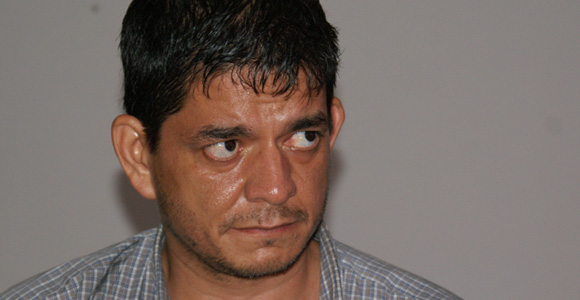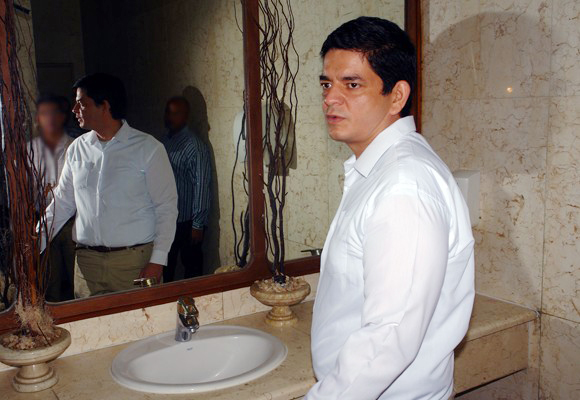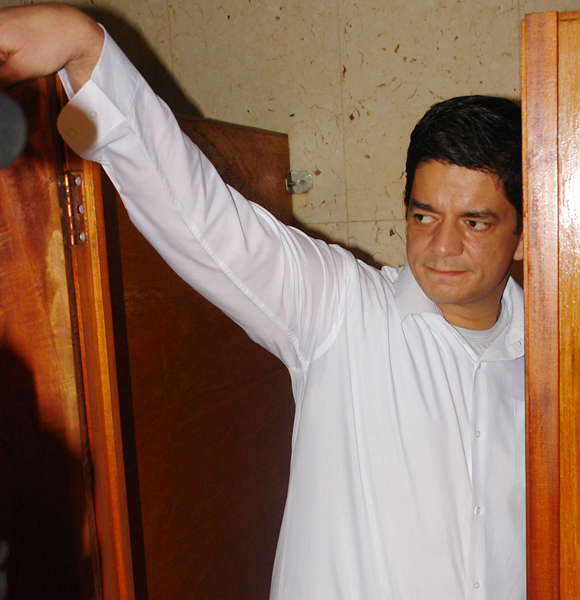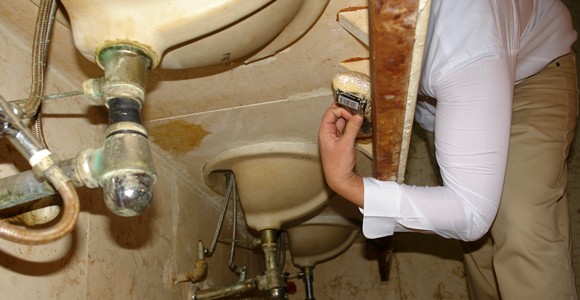 Luis Posada Carriles is still at large in the United States where he’s only being accused of migratory transgressions. However, the detention last July 1st of one of his paid terrorists, Salvadoran Francisco Chávez Abarca, El Panzón, must be a source of concern to him because of what this man knows and what he has done.
Luis Posada Carriles is still at large in the United States where he’s only being accused of migratory transgressions. However, the detention last July 1st of one of his paid terrorists, Salvadoran Francisco Chávez Abarca, El Panzón, must be a source of concern to him because of what this man knows and what he has done.
Wanted by INTERPOL, Chávez Abarca was trying to get into Venezuela. What for? asked President Hugo Chávez when he made his denunciation before the TV cameras in Venezuela.
The terrorist has confessed: he wanted to reproduce in that country a sinister plan which had already had “results” in Cuba in the 1990s, when a string of violent actions against hotels in the island nation, aimed at discouraging tourism, caused one fatality, several injured and great devastation. It was intended by the Miami rightwing sponsored by the various US administrations as a “master coup” to destroy a revolution that from 1959 has endured numerous criminal conspiracies intended for its obliteration.
Chávez Abarca was a major piece. He not only set up three of those explosive devices but also hired Central American mercenaries for similar missions. Last July, 13 years later, he resurfaced in Caracas, near the onset of the campaign for the legislative elections to be held this September 26 in Venezuela. The person behind his plans to undertake criminal actions and destabilize that country was the same: Luis Posada Carriles.
Transferred to Havana to face the charges brought against him, which had led to his inclusion in the Cuba INTERPOL red alert, Chávez Abarca has spared no details during the investigation and confirmed that in both countries the terrorists and the plans are quite the same.
According to his own confession, months before his arrival in the Maiquetía airport he had received instructions from the Cuban American National Foundation (CANF) and Posada to destabilize Venezuela.
They were excited over the coup d’état on José Manuel Zelaya in Honduras, on June 29, 2008, and toyed with the idea of a successful plot against Venezuela. They thought that “the left would be weakened because this was the country with the highest economic capability” in Latin America.
He says that during various meetings they brought up the need to embark on violent and destabilizing actions in Venezuela to try influencing the result of the elections. These included arranging demonstrations, burning tires, and assaulting National Assembly candidates and even President Hugo Chávez. He was also told that there was much money involved.
In the opinion of José Luis Méndez, an academic with the State Security Center for Historic Investigations (CIHSE), this tells us “that the terrorists are active and doing things; it sounds an alert.”
On the other hand, thorough researcher Eva Golinger thinks that subversion and aggression against Venezuela by such CIA front organizations as USAID and NED have intensified in light of the consolidation of the Bolivarian Revolution and its impact on other countries like Bolivia and Ecuador.
CLOSING THE CIRCLE
The onset of the investigation that will put Chávez Abarca on trial in Havana is not only shedding light on the dirty plans on Venezuela but it will also mark the continuation of the 1999 trials against Salvadoran mercenary Raúl Ernesto Cruz León and Guatemalans María Elena González Meza, Nader Kalam Musalam Barakat and Jazid Iván Fernández Mendoza, the people he recruited to sow terror in our country.

Chávez Abarca
Identified by León during his trial as “the man who recruited him,” Abarca has since then been proven guilty albeit he had yet to be brought to a court and before the Cuban people.
His actions against our country are part of the escalation of criminal actions carried out in the second half of the 1990s, when the type of terrorism that has characterized the anti-Cuban policy pursued by the US and the Miami Mafia materialized in a wave of brutal actions against Cuban tourist facilities.
Such actions would have the additional effect of selling to the world the image of a restless and combative opposition. The bomb blasts and arsons, which were the main features of sabotages in Cuba in the 1960s, were replaced by lethal devices that the terrorists assembled themselves before setting them up in places with a high concentration of tourists. Such devices could be programmed several days in advance.

The moment that the terrorist Chávez Abarca deplanes in Havana
They only needed a simple pocket calculator, a watch, a detonator, some wires and C-4, a powerful explosive looking like Plasticine, introduced in Cuba by the criminals in apparently harmless toothpaste tubes and flasks of deodorant or shampoo, as they pretended to be tourists. Actually, some of those C-4 caches seized could have blown up two flying planes. It was the same substance that Posada Carriles and his accomplices Guillermo Novo Sampol, Gaspar Jiménez Escobedo and Pedro Crispín Remón would try to use later to assassinate Commander in Chief Fidel Castro during the Ibero American Summit in Panama, in 2000.However, the people in charge of setting up the explosives in Cuba at that stage would not be Cubans, nor would they be coming from the United States. They would be mercenaries recruited in a third country, basically from the Central American region, where a ring of mercenaries paid by the CANF in Miami established their base.
One of their main leaders in Panama would be Posada Carriles, then a resident of El Salvador under such names as Ignacio and Ramón Medina, and Arnaldo Monzón Plasencia, a.k.a. El Joyero, a CANF director who, from that position, funded terrorist groups such as Alpha ‘66 based in Florida.

He explains how he planted the bomb in the bathroom
Then, around the years 1995 or 1996, Chávez Abarca met Posada at the Moldtrock car workshop owned by José Ramón San Feliú Rivera’s brother in the Salvadoran capital. There could be no better place since San Feliú was close to Posada Carriles, and just like his father, Ramón San Feliú Mayoral, he had close links with the rightwing party ARENA.

Here is where he activated the bomb.
In that first meeting, Posada proposed to bring explosives into Cuba, but later “he showed me everything, how to make a bomb.”
“He took care of the travel tickets, the accommodation, everything; I only had to give him my passport,” he says, and “he indicated that I could stuff the explosive in a pair of brown boots.”
He would be paid $2,000 for every bomb blast. He set up three but only one of them exploded. Still, the devastation at the Meliá Cohíba Hotel’s disco earned him congratulations from such people as Arnaldo Monzón, El Joyero; Guillermo Novo Sampol, Pedro Crispín Remón and Posada. “They wanted Cuba to be included in the list of countries ‘dangerous’ for tourists [...] There, I met Raúl Ernesto Cruz León and described the plans clearly to him, what was going to be done and where, and I said that he could decide whether it was possible or not, if he would do it or not, and he said yes, he said that if everything was OK he agreed to do it,” says Chávez Abarca during the investigation. “Then we buy Raúl a pair of boots to carry the explosives, the felt-tip pens to hide the detonators, and a clock -as an option-because you couldn’t bring in the batteries. Posada prepares everything for Raúl and gives it to me.”

The terrorist during the simulated reconstruction of the events.
“I don’t have good memories of Posada,” he says, for he deals with people “as if they were expendable objects.” It was he who said “that we had to go on setting up bombs.” Then, Abarca placed another one in Cuba’s commercial offices in the Mexican capital.
SUBVERSION AND TERRORISM ARE SYNONIMS
The story is well known: a young Italian tourist, Fabio Di Celmo, lost his life and various people were wounded during that wave of terrorism.
But the latest statements by Novo Sampol confirm that the criminal plans are not a thing of the past. On June 26, this partner of Posada Carriles, encouraged by the tolerance of the US administration said in an interview that he was not repentant of what he did in the past.
This terrorist, who justified the string of sabotages in Havana’s hotels, said in the same interview that his “friend” Posada “is very excited; he’s a very joyful man.”
This man and Posada, together with Jiménez Escobedo and Crispín Remón, were arrested in Panama in 2000, during the preparations of an assault on Fidel’s life that they planned to implement at the 10th Ibero American Summit in that country.
The four terrorists were pardoned in 2004 by President Mireya Moscoso, and they continue to hatch new plans with the impunity granted by Washington.
The victory of the Cuban Revolution on January 1st, 1959, drove the US hegemony in the Latin American continent into a crisis.
The political basis of the imperial system of domination based on the notion of National Security could not accept a different social system that transcended the scenarios of the decision-making centers of power. This is perhaps the premise to understand why subversion and terrorism were incorporated into the policy promoted against the island nation.
It’s no secret that after the fiasco of the mercenary invasion by the Bay of Pigs, in April 1961, the White House was forced to deal with a new reality: the Island could not be crushed through domestic or external coups d’état backed by propaganda campaigns and the manipulation of regional organizations, a method pursued until that moment to confront the Latin American revolutionary movements, as indicated by PhD Jacinto Valdés-Dapena Vivanco from CIHSE.
It was from Washington that intelligence operations were fostered to measure the content of the actions of the revolutionary forces, their prospects and projections; to establish rings of agents to carry out espionage, terrorism, sabotage and subversive propaganda; to systematically develop smear campaigns to discredit the Revolution’s political program and to create social and economic conditions in the country conducive to a counterrevolutionary political climate.
The United States then tried to isolate the Cuban Revolution diplomatically; to deploy the instruments of the economic warfare to thwart our social development and to fabricate, through covert means, the groups of so-called “dissidents” to offer the international public the image of a domestic political opposition as an alternative to the revolution.
A number of terrorist groups sponsored by the CIA have played an outstanding role in this dirty war against Cuba that started in 1959. Most of them chose to act towards the physical removal of Fidel, but their every plan has been dismantled and defeated.
EXAMPLES OF THE WAVE OF TERRORISM AGAINST CUBA IN THE LATE 1990′S
March 1995.- A bomb is set up in Varadero; Cuban terrorists Santos Armando Martínez Rueda and José Enrique Ramírez Oro are captured.
April 12, 1997.- A bomb explodes at the Meliá Cohíba Aché disco. The explosive was set up by Salvadoran terrorist Francisco Chávez Abarca.
April 30, 1997.- An explosive device is found and defused on the 15th floor of the Meliá Cohíba hotel. It was set up by Chávez Abarca.
July 12, 1997.- Bombs explode in the Capri and National hotels. They were set up by Otto René Rodríguez Llerena.
August 22, 1997.- Explosion at Sol Palmeras hotel in Varadero.
September 4, 1997.- Bomb blasts in the Copacabana, Chateau-Miramar and Tritón hotels and in the Bodeguita del Medio restaurant. The bombs were set up by Cruz León.
March 4, 1998.- Guatemalans María Elena González Meza and Nader Kalam Musalan Barakat are detained at the José Martí International airport as they try to introduce explosives in the country.
June 10, 1998.- Salvadoran Otto René Rodríguez Llerena is detained at the airport in his second trip to Cuba.

Path of Terror 1/3
Path of Terror 2/3
Path of Terror 3/3
Under the Sign of Terror (PDF 559 Kb)


